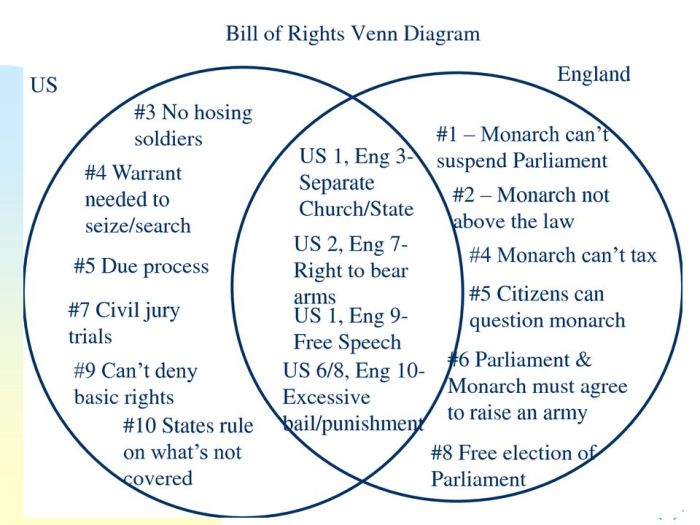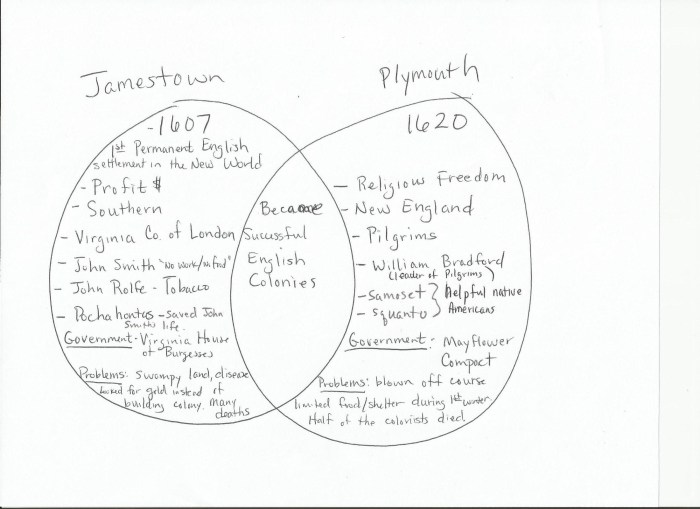Jamestown and plymouth venn diagram – Jamestown and Plymouth, the first permanent English settlements in North America, played pivotal roles in shaping the nation’s history and identity. This comparative analysis delves into their establishment, economic activities, social structures, governance, cultural exchange, and lasting legacies, revealing striking similarities and significant differences that shaped the course of American development.
Both Jamestown and Plymouth were founded by groups of English settlers seeking religious freedom and economic opportunities. However, their motivations and goals differed significantly. Jamestown, established in 1607, was driven primarily by the pursuit of wealth through the exploitation of natural resources.
In contrast, Plymouth, founded in 1620, was established by the Pilgrims, a group of religious dissenters seeking to establish a society based on their Puritan beliefs.
Historical Background

The establishment of Jamestown and Plymouth colonies marked significant milestones in American history. Both settlements were founded by groups of English colonists seeking religious freedom and economic opportunities in the New World.
Jamestown
Jamestown, founded in 1607, was the first permanent English settlement in North America. The Virginia Company, a joint-stock company seeking financial gain, established the colony. The settlers faced numerous challenges, including disease, starvation, and conflicts with Native Americans. Despite these hardships, Jamestown survived and became a thriving community.
Plymouth
Plymouth Colony was founded in 1620 by a group of English Puritans known as the Pilgrims. Seeking religious freedom, they established their colony in Massachusetts. The Pilgrims faced similar challenges to those encountered by the Jamestown settlers, including harsh weather conditions and conflicts with Native Americans.
However, they persevered and established a successful colony based on religious principles.
Economic Activities

Economic activities played a pivotal role in the development of Jamestown and Plymouth colonies. Agriculture, trade, and fishing were the primary sources of sustenance and income for the colonists.
Agriculture
Agriculture was the backbone of both Jamestown and Plymouth. The colonists grew a variety of crops, including corn, wheat, tobacco, and vegetables. Corn was a staple food for both Native Americans and colonists, and it was also used to make bread, beer, and whiskey.
Wheat was another important crop, and it was used to make flour and bread. Tobacco was a cash crop that was grown in large quantities in Jamestown. It was a valuable commodity that was exported to England and other European countries.
Trade
Trade was also an important economic activity in both Jamestown and Plymouth. The colonists traded with Native Americans for furs, skins, and other goods. They also traded with each other and with England. The colonists exported tobacco, corn, and other goods to England, and they imported manufactured goods, such as tools, clothing, and weapons, from England.
Fishing
Fishing was an important economic activity in Plymouth. The colonists fished for cod, mackerel, and other fish. They sold the fish to other colonies and to England. Fishing was also a source of food for the colonists.
The economic activities of Jamestown and Plymouth had a significant impact on the development of the colonies. Agriculture, trade, and fishing provided the colonists with the food, income, and goods they needed to survive and thrive.
Social Structure
Jamestown and Plymouth, the first permanent English settlements in North America, exhibited distinct social structures shaped by their respective economic activities, religious beliefs, and the availability of labor. This section analyzes the social hierarchies, class systems, and social customs prevalent in these colonies.
Social Hierarchy in Jamestown
Jamestown’s social hierarchy was characterized by a rigid class system, with planters at the apex. These wealthy landowners possessed significant political and economic power, controlling vast tracts of land and exploiting the labor of indentured servants and enslaved Africans. Below the planters were the indentured servants, who worked for a fixed period to pay off their passage to the colony.
They occupied a precarious position, often subjected to harsh treatment and limited opportunities for social mobility.
Social Hierarchy in Plymouth
Plymouth’s social structure was more egalitarian compared to Jamestown. The colony was founded by a group of religious dissenters known as the Pilgrims, who sought to establish a society based on their Puritan beliefs. Social status was primarily determined by religious affiliation and community standing, rather than wealth or land ownership.
However, a small elite of merchants and landowners gradually emerged, reflecting the colony’s growing economic prosperity.
Social Customs and Practices
The social customs and practices of Jamestown and Plymouth colonists were influenced by their respective cultural backgrounds and religious beliefs. In Jamestown, the Anglican Church played a dominant role in shaping social life, with regular church attendance and adherence to religious rituals being highly valued.
In Plymouth, Puritanism strongly influenced social norms, emphasizing strict morality, communalism, and the importance of education.
Governance and Leadership: Jamestown And Plymouth Venn Diagram

The governance systems in Jamestown and Plymouth differed significantly, reflecting their distinct origins and circumstances. Jamestown, established as a commercial venture by the Virginia Company, adopted a hierarchical structure with a governor appointed by the company. Plymouth, on the other hand, was founded by a group of Puritan Separatists who sought religious freedom and established a more democratic system of governance.
Jamestown
Jamestown’s government was headed by a governor who held extensive powers, including the authority to appoint and dismiss officials, impose taxes, and declare martial law. The governor was assisted by a council, which served as an advisory body. In 1619, the Virginia Company established the House of Burgesses, the first representative assembly in the American colonies.
However, the governor retained the power to veto legislation passed by the assembly.
Plymouth
Plymouth’s governance system was more democratic. The colony was led by a governor elected by the male residents. The governor shared power with a council of assistants, which was also elected by the community. The colony also established a General Court, which served as a legislative body and a court of law.
The General Court was composed of all male residents of the colony and had the authority to pass laws and elect officials.
Both Jamestown and Plymouth faced challenges in establishing and maintaining effective governance. Jamestown’s early years were marked by instability and conflict, as the colony struggled to survive in a hostile environment. Plymouth also faced challenges, including conflicts with Native American tribes and internal disputes within the community.
However, both colonies eventually developed stable and effective governance systems that helped them to prosper and grow.
Cultural Exchange and Conflict

The arrival of European colonists in Jamestown and Plymouth had a profound impact on the indigenous populations of North America. The interactions between the colonists and Native American tribes were complex and often fraught with conflict, but they also led to significant cultural exchange and assimilation.
Processes of Cultural Exchange and Assimilation, Jamestown and plymouth venn diagram
The colonists brought with them a variety of new technologies, ideas, and customs that were gradually adopted by Native Americans. These included firearms, metal tools, and agricultural practices. In turn, the colonists learned from the Native Americans about the local environment, how to cultivate crops, and how to navigate the wilderness.
Conflicts and Tensions
Despite the cultural exchange that took place, there were also significant conflicts and tensions between the colonists and Native Americans. These conflicts were often caused by competition for land, resources, and political power. In some cases, the conflicts escalated into violent warfare.
Legacy and Impact

The Jamestown and Plymouth colonies played a pivotal role in shaping the trajectory of American history. Their establishment marked the beginning of permanent European settlement in North America and laid the foundation for the development of American institutions, values, and culture.
The colonists brought with them their own political, economic, and social systems, which influenced the development of American society. The Virginia Company, which established Jamestown, implemented a system of representative government, while the Pilgrims who founded Plymouth established a more communal society based on religious principles.
Development of American Institutions
- The establishment of representative government in Jamestown served as a model for the development of democratic institutions in the United States.
- The Mayflower Compact, signed by the Pilgrims before landing at Plymouth, established a framework for self-governance and became a precedent for the American Constitution.
Values and Culture
- The colonists brought with them a strong work ethic and a belief in individual liberty, which became core values of American society.
- The Puritan influence in Plymouth shaped American religious and moral values, emphasizing piety, thrift, and hard work.
Ongoing Significance
The legacy of Jamestown and Plymouth continues to shape American identity. The sites of these colonies are now national landmarks, serving as reminders of the struggles and triumphs of the early settlers.
The principles and values established by these colonies continue to resonate in American society today. The ideas of self-governance, individual liberty, and religious freedom remain fundamental to the American experience.
Key Questions Answered
What were the primary economic activities in Jamestown and Plymouth?
Jamestown’s economy was centered around tobacco cultivation, while Plymouth’s economy relied on fishing, agriculture, and fur trading.
How did the social structures of Jamestown and Plymouth differ?
Jamestown had a rigid social hierarchy with planters at the top, followed by indentured servants and slaves. Plymouth had a more egalitarian social structure with a smaller gap between the wealthy and the poor.
What were the major challenges faced by the early settlers in Jamestown and Plymouth?
Both Jamestown and Plymouth faced challenges such as disease, starvation, and conflicts with Native American tribes.
